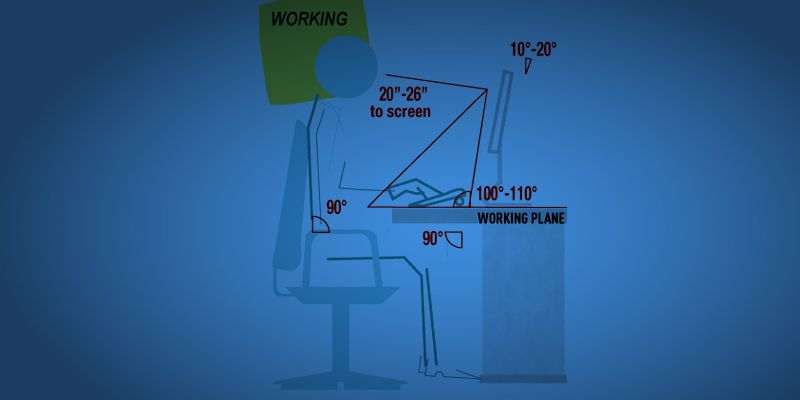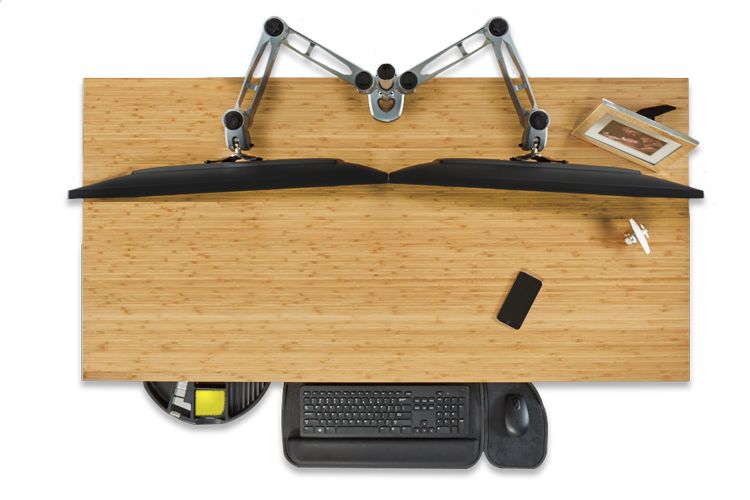Those of us who work in an office are familiar with the toll that aches and pains of repetitive tasks and bad posture can take. The National Institute for Occupational Safety and Health (NIOSH) and the Centers for Disease Control and Prevention (CDC) study ergonomics in the office. The goal is to eliminate disorders, reduce stress, and decrease injuries that occur with repetition, overuse of muscles, and poor posture. The result is designing tasks, workspaces, controls, displays, tools, lighting, and equipment that conform to physical capabilities and limitations. In other words, NIOSH has our best interests in mind when it comes to being healthy in the workplace.
Full Disclaimer: We are an office furniture dealer and sell some of the products we review. To learn more about the products we sell, our review process and why you can trust us, please visit: Why we’re different. Who is BTOD.com and The Learning Center?
Ergonomics in the Workplace Links
1. How Do Ergonomics Relate to Posture?

Ergonomists have tried to define positions that lessen the force of routines on our bodies. They found that we can significantly reduce risks if we follow these simple ergonomic principles:
- Make sure to have good posture
- Use large muscle groups when possible
- Bend from the middle to extend your range of movement
Putting these recommendations into practice means paying attention to your joint and muscle functions and changing your posture when necessary.
2. What Are Musculoskeletal Disorders?
Musculoskeletal disorders (MSDs) occur when your spine, joints, nerves, and muscles are injured. Work-related MSDs (WMSDs) occur when the work environment and activities aggravate the condition. For example, you might have eyestrain if you spend long hours working on the computer, or lower back pain if you sit in front of a screen all day. Other examples of WMSDs include:
- Tendonitis
- Elbow pain
- Rotator cuff injuries
- Carpal tunnel syndrome
- Sprains, strains, and tears
Because WMSDs affect the muscles, nerves, and tendons, you may be at risk for neck injuries, nerve damage, and back problems.
3. Impact of MSDs in the Workplace
In 2014, the Bureau of Labor Statistics (BLS) found that the industries with the highest WMSD rates are construction, health care, retail and wholesale trade, transportation, and warehousing. In fact, WMSDs are a major contributor to missed or limited work time. Regardless of what industry you work in, your employer is responsible for providing a healthy and safe workplace. Applying ergonomic principles and reducing WMSDs is a win-win situation for both you and your employer.
4. How Can Musculoskeletal Disorders Be Prevented in the Workplace?
Workers in a variety of occupations and industries are exposed to potential WMSDs at work, including working in awkward body postures, lifting heavy items, reaching overhead, bending, performing the same or similar tasks repetitively, and pulling and pushing heavy loads. Exposure to these known risk factors for WMSDs increases your risk of injury. The good news is that it is possible to prevent WMSDs. For instance, fitting the job to you instead of the other way around helps lessen muscle fatigue, increase productivity, and reduce WMSDs. You might recognize some of these employee programs that are becoming more frequently offered in the workplace:
- Healthy behavior programs, including nutrition, tobacco use, physical activity, and alcohol and substance misuse
- Health screening for blood pressure, obesity, cancer, diabetes, and cholesterol
- Mental health and depression screening and support programs
- Immunizations for the flu and pneumonia
Workplace health programs are basic investments in human resources, similar to other employee development programs such as training or mentoring.
5. What Are the Steps to Protect Workers From WMSDs?
It’s a simple fact: Putting an ergonomic process in place reduces the risk of WMSDs. While the process may seem daunting at first, steps just need to be taken to get the program started. Here are some essential elements of an ergonomic workplace health program:
- Provide management support. Management should establish and implement distinct goals and objectives for the ergonomic plan.
- Involve everyone. A participatory ergonomic approach enables everyone to provide valuable information about risks in the workplace.
- Provide training. Training ensures proper education of the benefits of ergonomics and the value of reporting early symptoms of WMSDs.
- Identify problems. It is crucial to recognize and evaluate ergonomic issues in the workplace before they result in WMSDs.
- Encourage reporting of WMSD symptoms. Early reporting can expedite the improvement method and help reduce or prevent the development of serious injuries, the progression of symptoms, and subsequent lost work time.
- Implement solutions. Multiple solutions exist for reducing, controlling, or eliminating workplace MSDs.
- Evaluate progress. As an ergonomic process develops, assessments should involve deciding if the goals have been met to help determine the success of the ergonomic solutions.
Regardless of which interventions are selected, using combinations can address several health issues at the same time.
6. The Future of Ergonomics in the Workplace
It’s in everyone’s best interest, both you and your employer, to apply ergonomics in the workplace, because poor working conditions result in physical aches and pains and have an adverse impact on your productivity. Some employers may even take the extra step to consult directly with a professional ergonomics specialist to analyze distinct working conditions and make recommendations. A partnership with the professionals, employers, and staff can help redesign the workplace to meet the needs of every employee.
Implementing an ergonomic plan doesn’t have to be an expensive endeavor. There are countless low-cost interventions for small and medium-sized companies without extensive resources to dedicate to employee health. For instance, awareness of your work environment is as essential as gaining control over your surroundings, such as adjusting lighting levels and obtaining user-friendly chairs. Control and information go a long way to decreasing stress levels. The end result is an enhanced return on investment for your health and your employer’s bottom line.
Additional Office Ergonomics Resources





